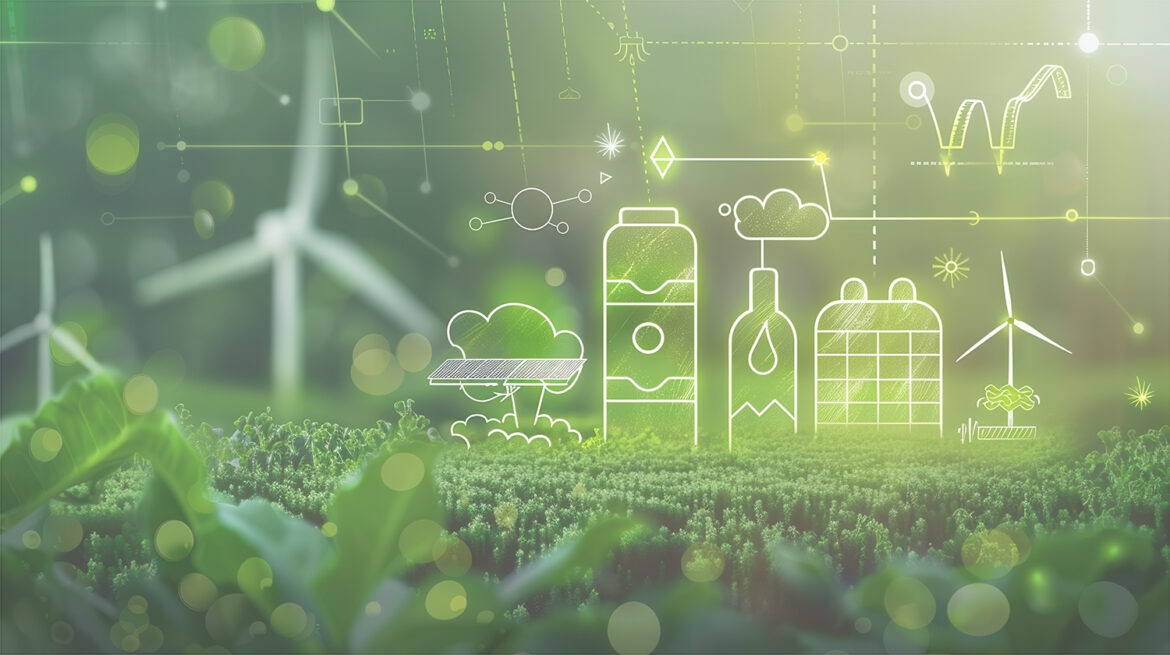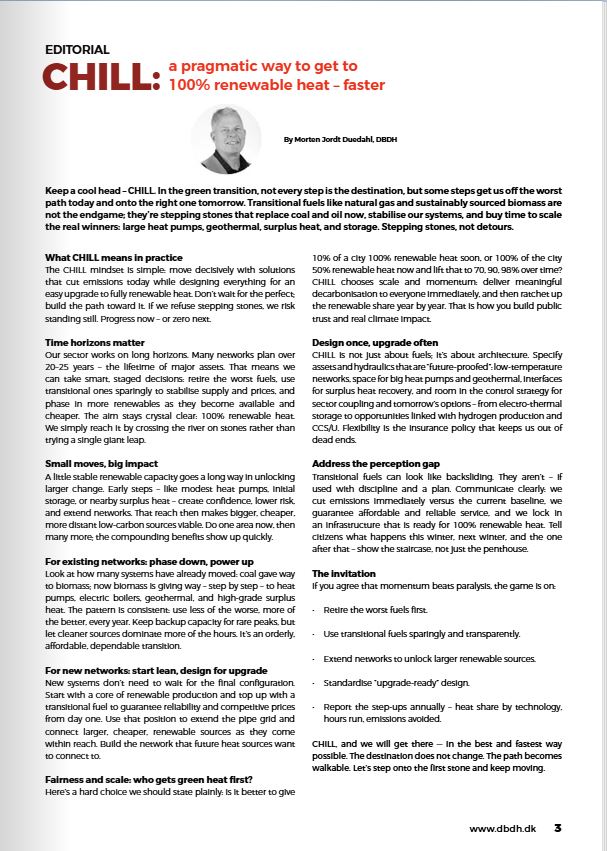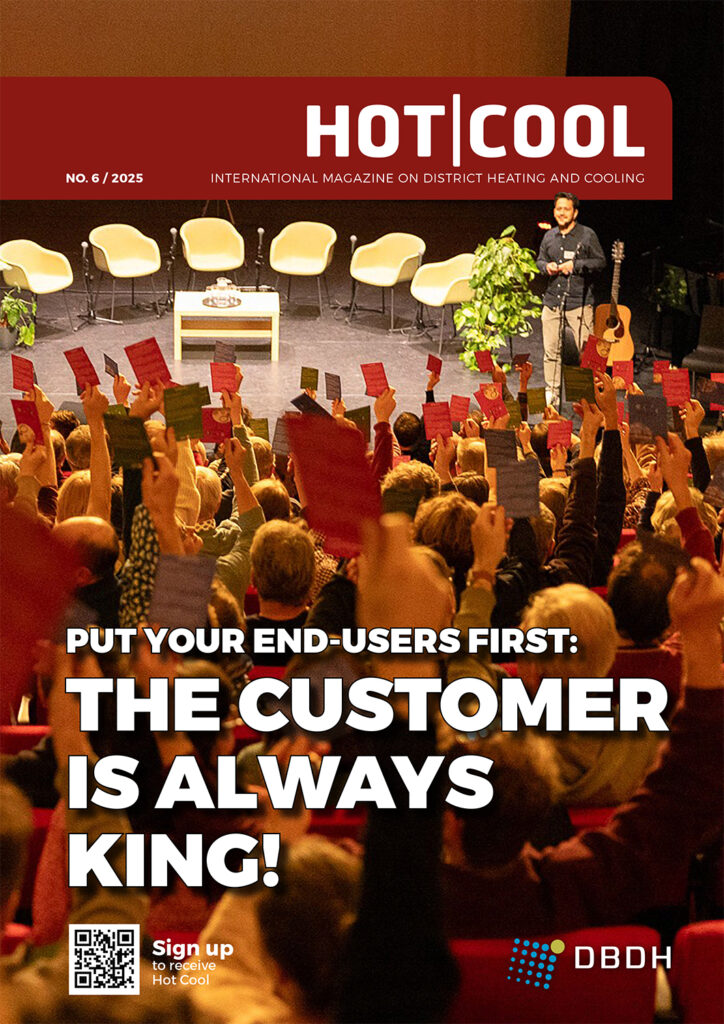Keep a cool head – CHILL. In the green transition, not every step is the destination, but some steps get us off the worst path today and onto the right one tomorrow. Transitional fuels like natural gas and sustainably sourced biomass are not the endgame; they’re stepping stones that replace coal and oil now, stabilise our systems, and buy time to scale the real winners: large heat pumps, geothermal, surplus heat, and storage. Stepping stones, not detours.
By Morten Jordt Duedahl, DBDH
Published in Hot Cool, edition no. 6/2025 | ISSN 0904 9681 |
What CHILL means in practice
The CHILL mindset is simple: move decisively with solutions that cut emissions today while designing everything for an easy upgrade to fully renewable heat. Don’t wait for the perfect; build the path toward it. If we refuse stepping stones, we risk standing still. Progress now – or zero next.
Time horizons matter
Our sector works on long horizons. Many networks plan over 20–25 years – the lifetime of major assets. That means we can take smart, staged decisions: retire the worst fuels, use transitional ones sparingly to stabilise supply and prices, and phase in more renewables as they become available and cheaper. The aim stays crystal clear: 100% renewable heat. We simply reach it by crossing the river on stones rather than trying a single giant leap.
Small moves, big impact
A little stable renewable capacity goes a long way in unlocking larger change. Early steps – like modest heat pumps, initial storage, or nearby surplus heat – create confidence, lower risk, and extend networks. That reach then makes bigger, cheaper, more distant low-carbon sources viable. Do one area now, then many more; the compounding benefits show up quickly.
For existing networks: phase down, power up
Look at how many systems have already moved: coal gave way to biomass; now biomass is giving way – step by step – to heat pumps, electric boilers, geothermal, and high-grade surplus heat. The pattern is consistent: use less of the worse, more of the better, every year. Keep backup capacity for rare peaks, but let cleaner sources dominate more of the hours. It’s an orderly, affordable, dependable transition.
For new networks: start lean, design for upgrade
New systems don’t need to wait for the final configuration. Start with a core of renewable production and top up with a transitional fuel to guarantee reliability and competitive prices from day one. Use that position to extend the pipe grid and connect larger, cheaper, renewable sources as they come within reach. Build the network that future heat sources want to connect to.
Fairness and scale: who gets green heat first?
Here’s a hard choice we should state plainly: is it better to give 10% of a city 100% renewable heat soon, or 100% of the city 50% renewable heat now and lift that to 70, 90, 98% over time? CHILL chooses scale and momentum: deliver meaningful decarbonisation to everyone immediately and then ratchet up the renewable share year by year. That is how you build public trust and real climate impact.
Design once, upgrade often
CHILL is not just about fuels; it’s about architecture. Specify assets and hydraulics that are “future-proofed”: low-temperature networks, space for big heat pumps and geothermal, interfaces for surplus heat recovery, and room in the control strategy for sector coupling and tomorrow’s options – from electro-thermal storage to opportunities linked with hydrogen production and CCS/U. Flexibility is the insurance policy that keeps us out of dead ends.
Address the perception gap
Transitional fuels can look like backsliding. They aren’t – if used with discipline and a plan. Communicate clearly: we cut emissions immediately versus the current baseline, we guarantee affordable and reliable service, and we lock in an infrastructure that is ready for 100% renewable heat. Tell citizens what happens this winter, next winter, and the one after that – show the staircase, not just the penthouse.
The invitation
If you agree that momentum beats paralysis, the game is on:
- Retire the worst fuels first.
- Use transitional fuels sparingly and transparently.
- Extend networks to unlock larger renewable sources.
- Standardise “upgrade-ready” design.
- Report the step-ups annually – heat share by technology, hours run, emissions avoided.
CHILL, and we will get there – in the best and fastest way possible. The destination does not change. The path becomes walkable. Let’s step onto the first stone and keep moving.
“CHILL: a pragmatic way to get to 100% renewable heat – faster ” was published in Hot Cool, edition no. 6/2025. You can download the article here:
Did you find this article useful?
Subscribe to the HOT|COOL newsletters for free and get insightful articles on a variety of topics delivered to your inbox twice a month!


